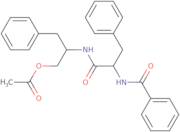Informations sur le produit
- (2S)-2-[(N-benzoyl-L-phenylalanyl)amino]-3-phenylpropyl acetate
- (2S)-2-[[(2S)-2-Benzamido-3-phenylpropanoyl]amino]-3-phenylpropyl acetate
- (αS)-N-[(1S)-1-[(Acetyloxy)methyl]-2-phenylethyl]-α-(benzoylamino)benzenepropanamide
- Asperglaucide
- Benzenepropanamide, N-[(1S)-1-[(acetyloxy)methyl]-2-phenylethyl]-α-(benzoylamino)-, (αS)-
- Benzenepropanamide, N-[1-[(acetyloxy)methyl]-2-phenylethyl]-α-(benzoylamino)-, [S-(R*,R*)]-
- Lyciumamide
- Matijin-Su
- O-Acetyl-N-(N′-benzoyl-<span class="text-smallcaps">L</smallcap>-phenylalanyl)-<smallcap>L</span>-phenylalaninol
- Sarapeptate
- Voir d'autres synonymes
- Saropeptate
- Tifentai
- benzenepropanamide, N-[(1S)-2-(acetyloxy)-1-(phenylmethyl)ethyl]-alpha-(benzoylamino)-, (alphaS)-
- O-Acetyl-N-(N′-benzoyl-L-phenylalanyl)-L-phenylalaninol
Aurantiamide acetate is a natural compound that belongs to the class of p-hydroxybenzoic acid amides. It has been shown to have neurotrophic effects in vitro, which may be due to its ability to inhibit mitochondrial membrane potential and release cytochrome c. Aurantiamide acetate also has significant cytotoxicity against cultured cells, with an IC50 of 2.5 μM. Aurantiamide acetate was found to inhibit bv2 microglial cells and induce apoptosis through the mitochondrial pathway by decreasing mitochondrial membrane potential and releasing cytochrome c. This compound is also found in the genus Aurantia, which includes plants such as the Orange Peel plant (Aurantia malaccensis).





